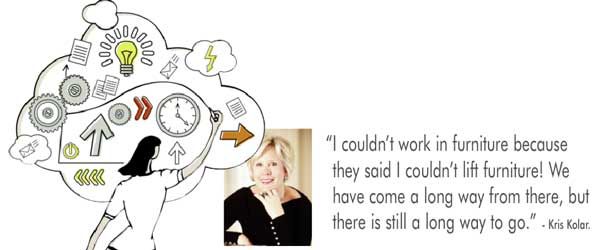Luxury department store visionary Marshall Field knew the importance of the female consumer in the 1860s when he coined the retail mantra, “Give the Lady What She Wants.” The furniture industry has long been known for its fraternal order of male domination and its primarily female consumer since the turn of the twentieth century. In 2009, the Harvard Business Review published “The Female Economy” demonstrating that 94% of global home furnishings purchase decisions are made by women. Having grown up as the daughter of an industry titan, and being one of a small handful of female Presidents in manufacturing, I can reasonably speculate that at least 94% of the leaders in manufacturing are male. I can also rightfully say that the industry network of good old boys is already starting to push back on my position with some of my dearest male colleagues questioning Harvard’s number; okay, let’s say it is 91%, or even 80%. Who am I to question Harvard? In any case, the furniture consumer is overwhelmingly female and is being served by primarily male leaders. The question I am exploring is whether or not the industry can be improved with more female leadership.

For over a year, I have been conducting research for a book on female leadership roles in furniture manufacturing. Furniture retail has more female leaders than the manufacturing sector, and this may be because this is where the rubber hits the road with the female consumer. In 2013, there were 80,000 women employed in furniture retail stores and 133,000 men according to the U.S. Bureau of Labor Statistics. Retailers are still challenged by the primarily male approach to product development and an inherent lack of understanding about what women want and how they shop differently from men.
In a 2010 article in Furniture World, “A Theory of How Women Shop,” Joe Capillo argued, “Our female consumers see only how things will work for them in their homes, and if they can’t see it, they won’t buy it.” This visioning of use, function, scale, proportion, color, and how objects will fit into a setting distinguishes the female home furnishings consumer from the male. A recent info-graphic on
www.Social4Retail.com reiterates the gender differences in furniture shopping habits and shows that men are more likely to focus on the furniture itself than the design scheme of the entire house. 74% of the women interviewed for this survey said they think about shopping all of the time; the men were most occupied with thoughts of expenditure 50% of the time, football 25% of the time, and beer the other 25% of the time. Whereas this
info-graphic may not be the most scholarly result—and is cheeky to be sure—we get the point.
Retail Opportunities
So where are the opportunities for women to help the $100 billion U.S. furniture retail industry serve its primary consumer, and how has gender affected the careers of its female leaders? I caught up with two female retail veterans to explore these topics.
Kris Kolar, A.S.I.D., Pro Member N.C.I.D.Q., and Vice President for Clive Daniel Home, has spent a long career as a female furniture retail warrior. Having an undergraduate degree in interior design and an MBA, here are the highlights of her career path:
- Interior Designer, Federated Department Stores’ Rike’s store in Dayton, Ohio
- Federated’s Rich’s division in Atlanta as Assistant Manager of all 10 Interior design studios
- John Wanamaker, Philadelphia as the Manager of the Interior Design Studios
- John Wanamaker as Divisional Vice President of Home Fashion
Throughout her career, Kris Kolar has felt that women have to work harder for the same recognition and equal pay. Sadly, female corporate executives in the U.S.A. today make 20% less than male executives doing the same job. Kolar said, “I have witnessed inequality through my entire career. I remember one time, midway into my career, when I needed to go to a male senior vice president for some advertising money and I felt like I had to be sweet and girly to get what I wanted. I hated that because I always play it straight and let the chips fall where they may. I could feel this shift in my brain that said, ‘you are stupid if you don’t take what people give you because you smile.’ Even down to what we wear, women are so scrutinized; there is a lot more for us to think about than what men have to.”
As a buyer, Kolar has had to deal with far more men than women. She also used the term ‘good old boy network’ to describe the industry. The critical thing she notices with male-driven design and manufacturing is the lack of connection with the female consumer. She explained that women are more practical when it comes to buying a piece of furniture and said, “They are more practical in their buying decisions and think about if a piece fits into the overall scheme, specific space, and whether it performs the functions it needs to.”

Male-driven manufacturers often consult with Kolar and the Clive Daniel team before coming to market with products. In too many cases, the nightstands are too low for mattress heights, dining tables have legs in the wrong place to sit properly, or drawers are just empty, without storage compartments. Kolar sends them back to the drawing board and wonders why there are not more female furniture designers who pay attention to such things.
In the course of my research, I have found that furniture design schools are, in many cases, graduating more females than males. Most of the over 30 young female graduates I have spoken with, have been turned away from, or simply turned off by, the reality of the male dominated manufacturing sector. I can only speculate that companies would do well to bring in more female design talent that would in turn help retailers reach their target audiences. Kolar pointed out that there is also a gender disconnect with the consumer when it comes to scaling sofas, “They are too large for most women.”
Generally, she has seen the industry shift slowly toward the female consumer and credits the fact that the industry has realized that furniture is fashionable. Fashion provided a critical gateway for women in the early days of furniture retail.
“Normally, retailers have been happy to hire women because they know about fashion. As more women entered, the product became more fashionable. When I first applied to Rike’s, I couldn’t work in furniture because they said I couldn’t lift furniture! We have come a long way from there, but there is still a long way to go.”
Caroline H.S. Hipple, Founding Partner in HB2 Resources has been a leader in both retail and manufacturing. Highlights of her career include:
- District Manager, This End Up Furniture
- Regional Sales Manager, This End Up Furniture
- Vice President, Marketing and Merchandising, This End Up Furniture
- Executive Vice President, Sales, Marketing, and Merchandising, This End Up Furniture
- President and COO, Storehouse Furniture
- Co-author, A Pathway to Profit: Culture Impacts Performance
Caroline Hipple admits that her experience has always been merit-based, and a network of smart, talented women supported her successful career at This End Up. “Company founder, Stewart Brown, had great foresight about the female consumer and he wanted women selling to women,” she explained. Hipple survived at This End Up through three different owners and became a major shareholder. “Because we sold what looked like shipping crates, people thought we were low-end and just cheap; we had a marketing and communications challenge,” she stated.
She led the company to be the first furniture store to open in regional malls all over the country. Next, she came back from the field to lead the marketing division at the Virginia headquarters and claims that she was ready for this big next executive step. Hipple said, “I had performed every job I was expected to lead and supervise, so I was very comfortable; You have to have that confidence to be a leader.” Her next step, however, was not so comfortable.
Hipple’s long experience, successful track record, and knowledge were not enough to land her the company’s Presidency. The board was searching for a new President and the female Human Resources consultant they hired told Caroline, “You know, if you were a man, they would hire you to be President.” They hired a man; he lasted 3 months.

In her six-year run as President of Storehouse, Hipple grew sales from $89 million to $150 million and expanded the chain from 42 to 72 stores. The revolutionary sales training and management development programs in creating a collaborative culture she developed at Storehouse feature prominently in her book, A Pathway to Profit.
When asked why there are more females in furniture retail than in manufacturing, she opined, “My experience has been that divisions mirror their consumer; the retail process is more unpredictable and perhaps women are better at multi-tasking. It is not a linear process. In retail environments, you are dealing with color, space planning, and design. We had many talented female and gay male consumers and I think it is more acceptable for them to be playing with lines and color.”
Perhaps the linear, predictable, highly structured manufacturing environments are less appealing to women.
One female furniture designer she credits with giving objects features that are important to women is Jenna Hall, recent inductee into the Furniture Hall of Fame. “When Jenna was at Aspen Home, she added great female features to the items and it really got noticed,” Hipple said, and added, “The industry can benefit from more female designers who understand how objects function; merchandising has totally changed from being suite-driven to being object driven.”
Like Kolar, Hipple strongly urges manufacturers to consult closely on product development with top retailers, because they are closest to the female consumer. As for the future of the industry, Hipple said, “We are lucky to have the 68 million children of the baby boomers going into their prime spending years. They do not want their parents’ furniture and they are more informed through the internet when they walk in a store than the consumer of 15 years ago. The future will be all about space planning with a collection of objects, and that is where women excel.”
This inquiry begs questions about gendered designs; is there such a thing as feminine furniture and masculine furniture, and does the gender of the furniture designer affect their designs? As an art historian, I argue that gender has nothing to do with the ultimate design. Let’s look at all of French Rococo period furniture; by today’s vernacular understanding most would call it “feminine,” yet it was all designed by men. In an article I wrote on the furniture designs of Alexa Hampton, she claimed that she has a “butch,” or more masculine approach to design. There are plenty of gay men making contributions to the furniture industry and one wonders if they have a more “feminine” sensibility, whatever that means. This topic is far too great to properly explore here, however, it is one that will be explored in my book at length because it goes to the very heart of the question of how more female designers might improve the industry; perhaps it is not about the overall look of a design to which women will contribute, but to the functionality and scale, as Kris Kolar observed.
It is reasonable to conclude that women have great contributions to make in both furniture manufacturing and retailing; that 94% number is just too big to ignore. Leadership positions are not for everyone, only alpha male and females. It indeed seems to be the case that alpha males may be doing the female consumer a disservice by limiting the advancement of alpha females. Perhaps we should take a note out of Hipple’s book on creating collaborative cultures to encourage more female participation in the industry; the collaboration of manufacturers, retailers, and consumers may attract more women. It is worth a shot!
What do you all think? I welcome your feedback here at Furniture World and on my blog at
http://www.
furniturefactorygirls.com.
Tips for Serving female customers
So, what can the furniture retail community do to better serve the female customer? Here is my checklist:
- Engage her in an inspired dialogue about her home through social media, blogs, and your website, all of which should offer visual cues and suggestions about planning spaces.
- Profile her individual needs and do NOT lump her into a box with all of your customers. She should be treated like an individual with her own personality and lifestyle she is expressing through her home. Therefore, don’t send a generic e-blast to her, but customize your messages according to her tastes. For example don’t send her a promotion for traditional designs if she is a modern girl.
- Thank her for her purchases—a lot! Send personalized thank you notes and even a gift of flowers or a plant for larger purchases.
- Ask her what she wants! Don’t be afraid to ask for feedback in the form of written surveys. Ask about style, quality, service, delivery, color, pattern, and more.
- Consult with her on what kind of products she wants to see in your stores; she should be your primary source of innovation!
- Conduct focus groups of 10 – 12 female customers on a regular basis to get feedback on your assortments before you go to market to shop for her. Buy them lunch, show them pictures, take a tour of the store and treat the ladies like the partners in your enterprise that they are. As Peter Drucker opined, “The purpose of a business is to create a customer.”
- Collaborate on designs with your suppliers before they bring out new products. Manufacturers are woefully lacking in conducting market research with the consumer in developing products and this severely limits their offerings.
AA Phi Beta Kappa graduate of Wofford College and art history honors M.A. graduate of Savannah College of Art and Design, Paula S. Fogarty’s professional career has focused on upper-level management in marketing, design, finance, and operations. As President of Kindel Furniture Company, Paula innovated product lines and streamlined operations for greater profitability.
As owner of her own marketing and strategic consulting firm, Paula Scott Unlimited, Paula assists both established brands and start-ups in creating consistent communications across all channels. She is currently developing furniture collections that address the needs of the female consumer.
Currently a freelance writer, Paula’s blog for Metropolis Magazine follows her book research on the role of women in the American furniture industry. She has written for Chair Culture, Connect Savannah, and served as Managing Editor for South magazine Paula has served as Board Chair of the Irish Georgian Society, The Center for Environmental Study, and The David Wolcott Kendall Memorial Foundation. She is a current board member of the Bernice Bienenstock Furniture Library, American Society of Furniture Designers, Rape Crisis Center of Savannah, Coastal Jazz Association, and Emergent Structures. She lives in Savannah with her Jack Russell Terrier, Charles.